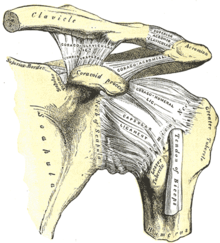Pulley lesion
| Classification according to ICD-10 | |
|---|---|
| M75 | Shoulder lesions |
| M75.8 | Other shoulder lesions |
| ICD-10 online (WHO version 2019) | |
A pulley lesion is damage to the rotator interval loop formed by ligaments that surrounds the long biceps tendon at the front of the head of the humerus in the so-called rotator interval and thus holds it in the correct position at this point. The rotator interval loop prevents the long biceps tendon from shifting towards the middle of the body (medially) and thereby ensures that it runs through the shoulder joint in accordance with the rules .
Anatomical basics
The biceps brachii muscle ( two-headed upper arm muscle ) is the second strongest flexor in the elbow joint. The tendon of the “long head” of this muscle runs diagonally through the shoulder joint in a groove ( sulcus m. Bicipitis longus ) in the head of the humerus. Your guidance in this position is ensured by the coracohumeral ligament. It is thereby functionally brought into a “ pulley position” ( pulley English for pulley).
Course of disease
In the course of degenerative changes in the shoulder joint or in the context of a rotator cuff rupture (especially when the tendon of the subscapularis muscle tears ), the guidance of the long biceps tendon can also be impaired by the structures mentioned above. The tendon then leaves its bearing in the sulcus bicipitis humeri and gets into the main joint ( articulatio humeri ). On the one hand, it causes irritation and restriction of movement; on the other hand, it is literally crushed by the surrounding joint parts. The consequence of this pathological condition is osteoarthritis in the shoulder joint and the thinning, later also the tear of the long biceps tendon.
treatment
A return of the tendon to its natural course regularly fails because the leading structures themselves are damaged and can no longer perform this task. Since the absence of the long biceps tendon is much less problematic than the consequences of its entrapment in the shoulder joint, the intra-articular tendon parts ( running in the joint ) are usually removed . In these cases, the shoulder is usually so damaged that the loss of the long biceps tendon is no longer functionally perceived and the patient accepts the reduction in pain by eliminating the entrapment as an improvement.
See also
- Biceps tendon dislocation in the dog
literature
- H. Hempfling: The pathomorphological substrate (PMS) as the basis for assessment in statutory accident insurance . In: J. Jerosch u. a. (Ed.): Training Orthopedics - Traumatology 8 . The ASG courses of the DGOOC. Steinkopff, Darmstadt 2003, ISBN 3-7985-1441-0 , p. 125 ff .
- W. Nakata, S. Katou, A. Fujita, M. Nakata, AT Lefor, H. Sugimoto: Biceps pulley: normal anatomy and associated lesions at MR arthrography. In: Radiographics: a review publication of the Radiological Society of North America, Inc. Volume 31, Number 3, 2011 May-Jun, pp. 791-810, ISSN 1527-1323 . doi : 10.1148 / rg.313105507 . PMID 21571657 . (Review).
Web links
Individual evidence
- ↑ Volker Echtermeyer, Stefan Bartsch: Praxisbuch shoulder. Systematically diagnose, treat and assess injuries and illnesses. 2nd Edition. Georg Thieme, Stuttgart / New York 2005, ISBN 978-3-13-102212-7 , p. 6 f.

